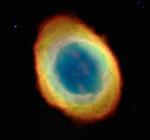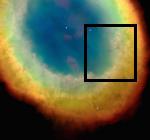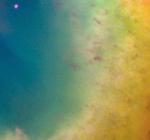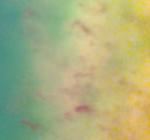 |
 |
 |
 |

 |
 |
 |
 |
For centuries, amateur and professional astronomers alike have been captivated by a faintly glowing doughnut, named the Ring Nebula, which lies in the constellation Lyra. The Ring, first cataloged over 200 years ago by French astronomer Charles Messier and called M57, is the best-known example of a planetary nebula. It is a cloud of gas ejected from the doomed star at its center.
Now, astronomers have used NASA's Hubble Space Telescope to obtain the sharpest view yet of the Ring Nebula. The Hubble images reveal that the Ring actually has a cylindrical or hourglass shape. Its apparent nearly circular appearance is due only to its being seen almost end-on. Such elonged shapes are common among other planetary nebulae, because thick disks of gas and dust around the waist of the star slow down the expansion in that direction, leaving the gas free to flow out perpendicular to the disk.
The Ring Nebula is about 2000 light years from Earth, and has a diameter of about one light year. The faint speck at its center was once a star of greater mass than our own Sun. Now, near the end of its life, it has ejected its outer layers into space, and the remnant is destined to die as a tiny white dwarf star, about the size of the Earth.
This new view was obtained in October by the Hubble Heritage Program team at the Space Telescope Science Institute in Baltimore, Md., the Hubble telescope's operations center. The Heritage team, comprised of astronomers and image-processing specialists, selected this most famous of planetary nebulae as its first new target for the orbiting observatory.
Each month, the Heritage Program will treat the public to a new sampling of celestial views from the Hubble Telescope. Until now, the pictures have been drawn from the telescope's treasure trove of archival images, and have been byproducts of the main purpose of the observations, scientific research. But the Heritage team will also occasionally employ the space observatory to obtain new images of pictorially stunning sky objects, using a small amount of the Institute Director's discretionary time which he has made available.
"We made the Ring Nebula our first new target because it is so well known among amateur astronomers," explains Heritage team astronomer Howard Bond, who was once an amateur himself. "We knew the Ring photo would be spectacular because we had already imaged a portion of the nebula with short Hubble exposures in 1995, and what we saw was absolutely amazing." Adds Heritage Project head scientist Keith Noll, "We knew we had to go back and finish the Hubble picture of the entire Ring Nebula. In the future, we will involve members of the public, and astronomers from other institutions, in the selection of the next celestial targets for Hubble Heritage observations."
In this colorful image, taken with Hubble on October 16, 1998, appearances are deceiving. What looks like an elliptical ring is actually believed to be a cylindrical or barrel-shaped structure, surrounding the faint central star, which is seen as a small white dot in the center. The Ring looks nearly round only because we are looking down the axis of the cylinder.
Bond recalls that "I first saw the Ring through a small telescope in my back yard, when I was a high-school student in the 50's. My astronomy books taught me that it was a round sphere of expanding gas." In fact, the round shapes of planetary nebulae when seen in small telescopes gave rise to the name two centuries ago: their circular disks resemble those of planets, and thus they were called nebulae with a "planetary" shape.
Astronomers have, however, suspected for some time that the Ring Nebula actually has an elongated shape, and looks round only because of our viewing angle. Close examination of the Hubble image strongly supports this newer opinion. The photo shows numerous small dark clouds of dust that have formed in the gas flowing out from the star, and are silhoutted against more distant bright gas. These small, dense dust clouds are too small to be seen with ground-based telescopes, but are easily revealed by Hubble.
Remarkably, the dark dust clouds are only seen in the outer portions of the Ring Nebula; none are seen silhoutted against the central region. This proves that they are not distributed in a uniform sphere, but are instead located only on the walls of the cylinder. Many of the dust clouds are elongated in directions pointing away from the central star, due to the forces of radiation and gas outflow from the star.
The color image of the Ring was built up from three black-and-white photos taken through different color filters with the Hubble Telescope's Wide Field Planetary Camera 2. Blue isolates emission from very hot helium, which is located primarily close to the hot central star. Green represents ionized oxygen, which is located further from the star. Red shows ionized nitrogen, which is radiated from the coolest gas, located furthest from the star. The gradations of color illustrate how the gas glows because it is bathed in ultraviolet radiation from the remnant central star, whose surface temperature is a white-hot 120,000 C.
The Heritage team is already planning its next new Hubble observations. A list of candidate targets, this time several spectacular edge-on galaxies far beyond the Milky Way, will be posted on the team's web site, and the public will be allowed to vote for their favorite. The winner will be observed with Hubble in the spring of 1999, and the new images made available shortly thereafter. Those wishing to vote should set their internet browsers to http://heritage.stsci.edu/.
"People have an intense interest in everything Hubble does," Noll says. "The Heritage Project is a wonderful way for the public to participate directly in the process of selecting Hubble targets. The turnaround will be relatively quick. The process, from voting to public release, should take about three to four months. Although the main purpose of the Hubble Heritage observations is to provide the spectacular images to the public, our data--including the new Ring Nebula images--will also be released to the professional astronomical community at the same time in digital form, so that detailed scientific analyses can be conducted."
(This links to the early HST image mentioned in the text. Use your browser's "Back" button to return to this page. (Back to story above.))
The Hubble Heritage Project was unveiled in October 1998, with the aim of providing the public with pictorially striking images of celestial objects obtained with the Hubble Space Telescope.
The Heritage Project will primarily select, process, and release the most visually compelling images available in the HST archive, but will on occasion obtain new images of objects selected for their pictorial, rather than purely scientific, impact. The public will be asked to join in target selection for these new observations. The digital image data will be placed immediately into the HST archive, for the benefit of interested professional astronomers.
For our first new Heritage observation, we selected the famous Ring Nebula in Lyra (M57 = NGC 6720). This object is so large (the major axis of the bright ring is about 90") that it required two WFPC2 telescope pointings to cover it entirely. We imaged M57 in three emission-line species, color-coded as follows in the final rendition of the image: He II 4686 A (blue), [O III] 5007 A (green), and [N II] 6584 A (red).
In addition to its pictorial and outreach appeal, the image reveals a host of subarcsecond dark globules around the periphery of the nebula. The fact that no globules are seen projected against the central region demonstrates that their distribution is in fact toroidal or cylindrical, rather than spherical. Thus the Ring Nebula is in fact a non-spherical, axisymmetric planetary nebula (like many other PNe), which we happen to view from a direction close to its axis of symmetry. A ground-based kinematical study by Bryce, Balick, & Meaburn (1994, MNRAS, 266, 721) indeed supports the probable bipolar geometry and low viewing angle.
Back to top of this page.
Email and other contact information.